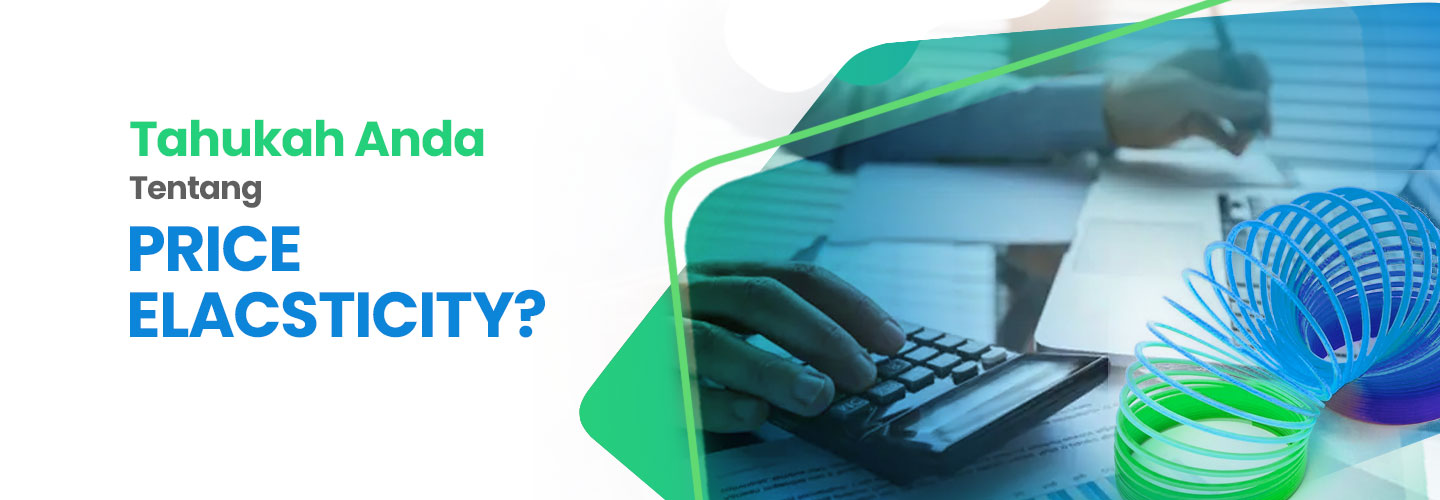Pengertian Price Elasticity dan Penggunaannya dalam Perusahaan

Menentukan harga yang tepat bagi produk atau jasa Anda merupakan sebuah hal yang sulit. Hal ini adalah salah satu hal krusial yang harus dilakukan marketer karena berdampak pada laba perusahaan. Salah satu elemen penting dari penetapan harga adalah memahami price elasticity.
Apa itu Price Elasticity?
Pada umumnya sebagian besar pelanggan di banyak pasar bersikap sensitif terhadap harga produk atau layanan. Asumsinya, lebih banyak orang yang akan membeli produk atau layanan jika harganya lebih murah dan lebih sedikit yang akan membelinya jika harga produk lebih mahal.
Namun, fenomena tersebut dapat diukur lebih dari teori karena elastisitas harga menunjukkan dengan tepat seberapa responsif permintaan pelanggan terhadap suatu produk berdasarkan harga. Price elasticity atau elastisitas harga adalah perbandingan/rasio persentase perubahan kuantitas suatu barang yang diminta dengan persentase perubahan harga barang itu sendiri. Marketers perlu memahami tentang produk mereka ketika memikirkan untuk menetapkan atau mengubah harga.
Anda perlu memahami seberapa elastis produk, sensitivitasnya terhadap fluktuasi harga, atau inelastis, serta sebagian besar ambivalen tentang perubahan harga. Beberapa produk memiliki respons yang jauh lebih cepat dan dramatis terhadap perubahan harga, karena biasanya dianggap bagus untuk dimiliki atau tidak penting, dapat juga karena banyak pengganti yang tersedia.
Bagaimana cara menghitungnya?
Berikut adalah rumus elastisitas harga permintaan:
Elastisitas harga permintaan = Persentase perubahan kualitas yang diminta
Persentase perubahan harga
Sebagai contoh, bisnis yang menjual pakaian menaikkan harga salah satu jaketnya, dari Rp100.000 menjadi Rp120.000, maka kenaikkan harganya adalah 20%. Kemudian kenaikan harga tersebut menyebabkan adanya penurunan jumlah jaket yang terjual, dari 1.000 jaket menjadi 900, maka penurunan permintaannya menurun menjadi -10%. Jika dimasukkan ke rumus elastisitas harga permintaan menjadi:
-10% = - 5 atau 5
20%
Sebagai catatan angka negatif biasanya diabaikan dan nilai absolut dari angka tersebut digunakan untuk menafsirkan metrik elastisitas harga. Besarnya jarak dari nol yang penting dan bukan positif atau negatif. Semakin tinggi nilai absolut dari angka tersebut, semakin sensitif pelanggan terhadap perubahan harga.
Terdapat lima zona elastisitas produk dan layanan:
-
Perfectly elastic atau elastis sempurna dimana setiap perubahan harga yang sangat kecil mengakibatkan perubahan yang sangat besar dalam jumlah yang diminta. Produk yang termasuk dalam kategori ono sebagian besar adalah komoditas murni. Tidak ada merek, tidak ada diferensiasi produk, dan pelanggan tidak memiliki keterikatan yang berarti pada produk.
-
Relatively elastic atau relatif elastis dimana perubahan kecil dalam harga menyebabkan perubahan besar dalam jumlah yang diminta (hasil rumus lebih besar dari 1). Daging sapi adalah contoh produk yang relatif elastis (karena dapat diganti dengan daging ayam atau kambing).
-
Unit elastic dimana setiap perubahan harga diimbangi dengan perubahan kuantitas yang sama (jumlahnya sama dengan 1).
-
Relatively inelastic dimana perubahan harga yang besar menyebabkan perubahan permintaan yang kecil (jumlahnya kurang dari 1). Bensin adalah contoh yang baik di sini karena kebanyakan orang membutuhkannya, jadi meskipun harga naik, permintaan tidak banyak berubah. Produk dengan merek yang lebih kuat juga cenderung lebih tidak elastis, hal ini menunjukkan membangun ekuitas merek menjadi investasi yang baik.
-
Perfectly inelastic atau inelastis sempurna yaitu saat jumlah yang diminta tidak berubah kita harga berubah. Produk dalam kategori ini adalah hal-hal yang benar-benar dibutuhkan konsumen dan tidak ada pilihan lain untuk mendapatkannya. Hal ini dapat dilihat dari kasus dimana perusahaan memiliki monopoli atas permintaan.
Marketers harus tahu di mana produk/jasa mereka berada pada spektrum ini, tetapi jumlah sesungguhnya kurang penting dibandingkan dengan mengetahui ada di zona pada produk/jasa Anda dan apa yang akan terjadi jika ada perubahan harga.
Bagaimana perusahaan menggunakannya?
Ini adalah salah satu metrik utama bagi manajer pemasaran untuk menciptakan produk dan layanan yang memiliki nilai unik dan berkelanjutan bagi pelanggan dibandingkan dengan opsi lain yang tersedia bagi mereka di pasar. Elastisitas harga menjadi cara untuk mengukur kinerja. Produk yang sangat elastis dianggap sebagai komoditas oleh konsumen.
Tujuan pemasar adalah memindahkan produk/jasanya dari relatively elastic ke relatively inelastic. Hal ini dilakukan dengan menciptakan sesuatu yang berbeda dan bermakna bagi pelanggan. Melalui branding atau inisiatif pemasaran lain, perusahaan meningkatkan keinginan konsumen atas produk serta ketersediaan membayar terlepas dari harga.
Perlu diingat bahwa elastisitas harga bukan hanya faktor seberapa baik Anda memasarkan. Hal ini juga dipengaruhi oleh jenis produk yang Anda jual, pendapatan target konsumen Anda, kesehatan ekonomi, dan apa yang dilakukan pesaing Anda.
Apa saja kesalahan umum yang dilakukan manajer dengan elastisitas harga?
Banyak pebisnis yang berasumsi bahwa mereka memahami gambaran lengkap berdasarkan pengalaman mereka menentukan harga produk mereka di pasar. Perubahan harga yang lebih ekstrim dapat menimbulkan tanggapan konsumen yang berbeda secara signifikan.
Namun, sulit untuk menentukan bagaimana hal itu akan dimainkan di pasar karena elastisitas harga adalah konsep yang dinamis. Apa yang secara historis bersedia dibayar oleh konsumen untuk produk tertentu belum tentu mau mereka bayar dengan kondisi yang sama pada hari ini atau di masa mendatang.
Oleh karena itu, elastisitas seringkali merupakan perhitungan tidak tepat. Salah satu cara yang dapat dilakukan adalah dengan A/B testing di pasar. Lakukan rilis produk Anda pada titik harga yang baru dan lihat permintaan yang muncul, lalu bandingkan dengan produk yang sama dan harga berbeda.
Untuk mendapatkan penetapan harga yang paling akurat, penting untuk mempertimbangkan persaingan pasar, konsumen, dan unsur biaya. Hal ini juga memberikan bobot tantangan pada penetapan harga yang bisa dipelajari melalui Marketing Pricing Strategy bagi para pemangku kepentingan.